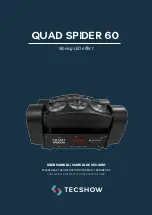
10
optics11life.com
the sample while optical fiber reads out cantilever bending during indentation. The cantilever acts as a
spring to measure the stiffness of the deformed material.
Figure 6:
Force sensor (probe) design.
Selecting the right probe
Although a specific probe can measure a wide range of Young’s
moduli, selecting a probe with suitable
parameters that match with the specific sample properties can enhance the quality of the measurement.
For a softer sample, a probe with a less stiff cantilever is needed, and vice-versa, to ensure that significant
cantilever bending as well as significant sample indentation is achieved during measurements. If the
probe is either too stiff or too soft, there will be minimal cantilever bending or indentation respectively,
resulting in a less optimal signal-to-noise ratio.
Advised cantilever stiffness is provided
for ranges of sample Young’s moduli in the table below
. These are
estimated for a tip radius of 25 µm, indentation depth of 2 µm. The full range is given considering
minimum cantilever bending of 0.01 µm and a maximum of 30 µm. The optimal range is given for
cantilever bending of 0.05 µm and a maximum of 20 µm.
Table 1:
Young’s modulus and advised cantilever stiffness range (tip radius of 25
µm and indentation depth of 2 µm)
Full range of Young's modulus
Optimal range of Young's modulus
Advised cantilever stiffness range
10 Pa
–
30 kPa
50 Pa
–
20 kPa
0.025 N/m
100 Pa
–
298 kPa
500 Pa
–
199 kPa
0.25 N/m
2 kPa
–
6 MPa
10 kPa
–
4 MPa
5 N/m
20 kPa
–
59 MPa
99 kPa
–
39 MPa
50 N/m
60 kPa
–
179 MPa
298 kPa
–
119 MPa
150 N/m
For a tip radius of 3 µm and indentation-depth of 0.5 µm:
Table 2:
Young’s modulus and advised cantilever stiffness range (tip radius of 3
µm and indentation depth of 0.5 µm)
Full range of Young's modulus
Optimal range of Young's modulus
Advised cantilever stiffness range
230 Pa
–
688 kPa
1.1 kPa
–
459 kPa
0.025 N/m
2.3 kPa
–
6.9 MPa
11 kPa
–
4.6 MPa
0.25 N/m
46 kPa
–
137 MPa
229 kPa
–
92 MPa
5 N/m











































